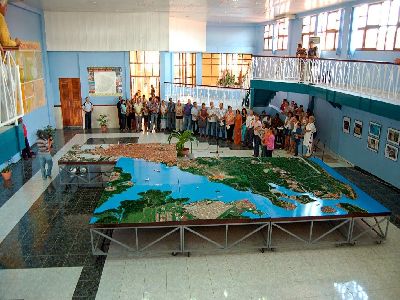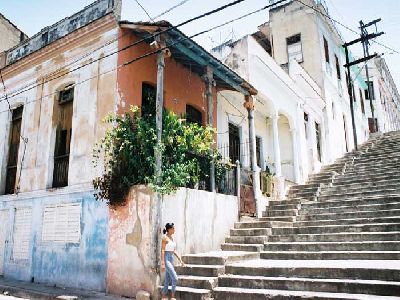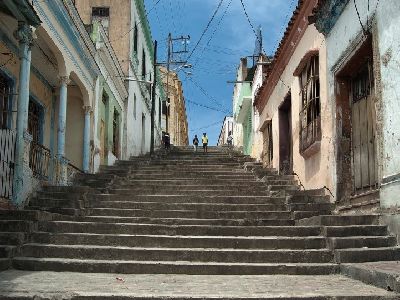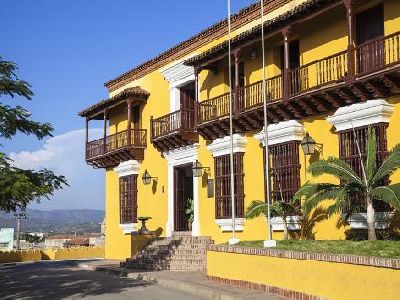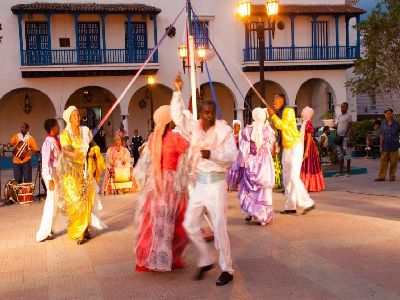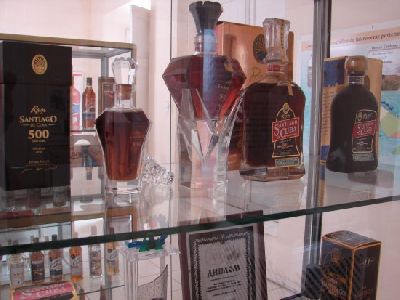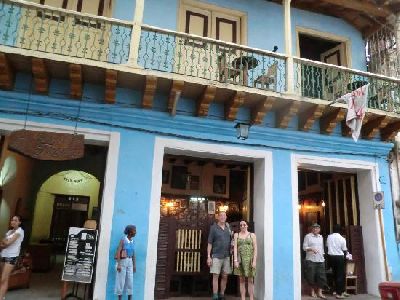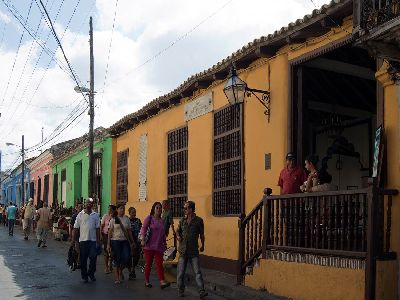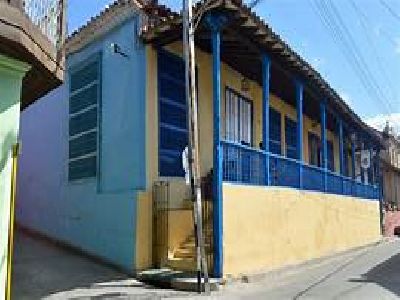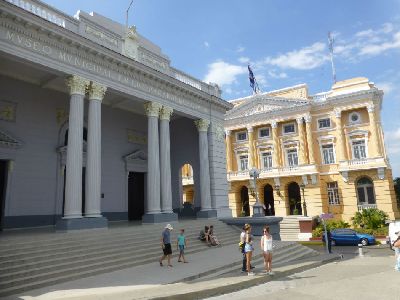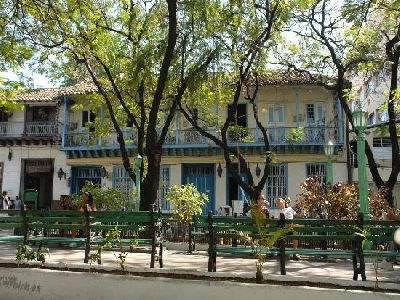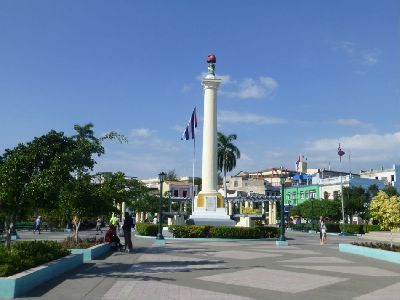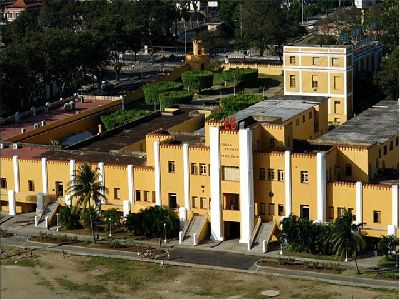Places
Hotel Casa Granda
Belonging to the Cubanacán Hotel Chain, the Hotel Casa Granda it is one of the emblematic hotels of Santiago de Cuba, which in 2014 celebrated its 100th anniversary.
This place was the seat of a stately home of the Fernández de Granda family, used as a hostel at the end of the 19th century. In 1909, the Cuban Railroad Company bought it to build a hotel building, a project commissioned to architect Carlos Segrera.
The construction of the building culminated on January 1, 1914....
Balcón de Velázquez
The work was in charge of the contractor and architect Javier Ravelo Meneses. In September 1953, with the presence of the Municipal Mayor, civil authorities, military, and government, the "Balcón de Velázquez" was officially inaugurated.
The intention was to provide the city with a viewpoint, to collect the history of the first moments of Santiago de Cuba, its first defense bastion, as well as significant personalities that transcended the time of the founding...
Maqueta de la Ciudad de Santiago de Cuba
This site houses a model of the city of Santiago de Cuba, which offers a specialized tour on this which exposes the urban growth of the city of Santiago de Cuba.
It also has a permanent photographic exhibition and a snack-bar.
Barrio El Tivolí
Neighborhood of Santiago de Cuba that melts in itself the cultural syncretisms and ethnic exchanges of the Cuban nationality.
It had an urban impulse in the heat of the Haitian Revolution at the end of the 18th century and the beginning of the 19th.
It belongs to the French memory in this city, and constitutes an emblem of it, whose history is intimately linked to the Tivolí. It has two other attractions: the Museum of the Clandestine...
Escalinata de Padre Pico
Built in 1899 under the auspices of Mayor Emilio Bacardí and in honor of the Catholic priest Bernardo del Pico Redín, it is one of the most well-known streets in Santiago de Cuba.
It is revealed as a true natural viewpoint, and one of the doors of the El Tivolí neighborhood. It has 52 steps grouped in 13 blocks of 4 steps each, and 12 breaks.
Museo de la Lucha Clandestina
Located in the Loma del Intendente, in the neighborhood of El Tivolí. If you are looking for the main sites of interest in Santiago de Cuba, the Museum of the Clandestine Struggle is for you.
This museum treasures a part of the history related to the struggle against the tyranny of Fulgencio Batista, especially the role of the city of Santiago de Cuba, and the actions carried out in the cities and towns in support of the Rebel Army and the...
Tumba Francesa: La Caridad de Oriente
The French Tomb: "La Caridad de Oriente", was declared an Oral and Intangible Heritage of Humanity in November 2003. The Tumba Francesa de Santiago de Cuba is a recreational cultural space, which has its origins in the nineteenth century.
In this form of artistic expression, African slaves fused their rhythms with the French dances of the Caribbean. Cuba arrived from Haiti and appears in the coffee plantations of the east of the island, where it evolves to adopt different structures that crystallize...
Museo del Ron en Santiago de Cuba
The Rum Museum was founded in June 1996. This museum in Santiago de Cuba collects the history of rum production, with five exhibition halls, where they rely on the photography and samples of the first rum productions to date.
Information is also provided about sugar cane as raw material for rum production. In addition there is an area of aging barrels and a variety of labels and containers of rums are exhibited, from old and missing brands such as Methuselah and the Caribbean Club, to others that last...
Casa de la Trova en Santiago de Cuba
The Directorate of the Government of Santiago de Cuba approves the foundation of the Casa de la Trova José "Pepe" Sánchez, with the aim of maintaining, disseminating, and taking to all corners of the world, troubadour and traditional Cuban music.
In this site, musical groups and small format ensembles of traditional Cuban music are presented. It also hosts the International Trova Festival "Pepe Sánchez", which is held every year in September,...
Casa Natal José María Heredia
Because of its historical and architectural values, José María Heredia's birthplace is created to preserve one of the relics of the colonial era of the city.
Documents, paintings and objects from the period that belonged to the Heredia family are exhibited in this museum in Santiago de Cuba.
It is the main institution dedicated to promoting the life of the first romantic poet of America, known as the singer of the Niagara.
Museo del Carnaval Santiaguero
The Carnival Museum was inaugurated in June 1983, and collects the different stages of this popular demonstration that in July fills the city with music and dance.
Its rooms are completely devoted to the history of these popular festivities, with a seal that distinguishes them from those carried out in other parts of the island, mainly due to the fact that in their origins they mixed Spanish, African and Franco-Haitian influences.
This institution exhibits models of floats, trophies, costumes, capes, street ornaments,...
Museo Bacardí
Inaugurated as a Municipal Museum, today the Emilio Bacardí Provincial Museum, it was the first such institution opened in Cuba in 1899. Its creator and promoter was Don Emilio Bacardí Moreau, first mayor of Santiago de Cuba.
She treasures valuable samples of pre-Columbian culture, national art and Cuban history, among the latter, various objects that belonged to the National Hero of Cuba, José Martí, as well as personal objects of the Father of the Fatherland...
Plaza Dolores
It is one of the busiest spaces of the Historic Center. In the center stands a full-length statue of the hero Francisco Vicente Aguilera, a native of the neighboring city of Bayamo. Houses of the colonial stage host several restaurants and the Dolores Tavern. The most notable building, the old church of Dolores, has been converted into a beautiful concert hall, today the headquarters of the Orquesta Sinfónica de Oriente, as well as the headquarters of the International Choir Festival of Santiago de Cuba, which is celebrated in our city every Two years in the month of November.
Plaza de Marte
It is one of the most central spaces of the city, emerged at the end of the 18th century. The square is a tribute to the independence of Cuba. By municipal agreement, in June 1899 it was given the name of Plaza de la Libertad, although the people of Santiago continued to call it Plaza de Marte.
It is one of the favorite places of the inhabitants of Santiago. In its surroundings you can find institutions the Iris Jazz Club, the Rex and Libertad Hotels of the Islazul Hotel Chain, the Patio los Dos Abuelos,...
Cuartel Moncada
This Cuban military headquarters went down in history after the assault of a group of young people led by Fidel Castro who aimed to take the barracks and then head to the mountains of Santiago de Cuba to begin the fight against the dictatorship of Fulgencio Batista.
It currently houses the School City July 26, and in one of the facilities is a museum that reflects details of the action produced there on July 26, 1953.


